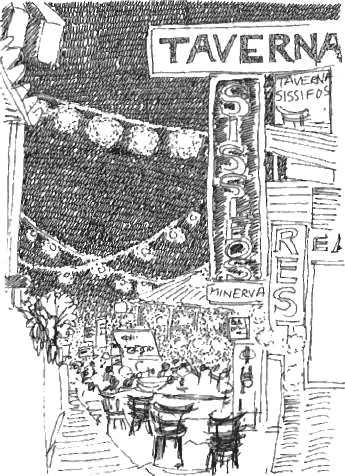
I AM not quite sure how many tourists are expected in Greece this year but I think it is in the vicinity of four or four and a half million. Naturally, they do not all come at the same time but by far the greatest numbers will arrive between this month and the end of September. This means that for the next four months at least three out of ten people you run into in the streets of Athens will not be Greeks but travellers hailing from the United States, Britain, Germany, France, Italy, Spain, the Scandinavian countries, the Low Countries, Australia, New Zealand, Japan and even Latin America.
About ninety percent of these innocents will, at some time during their sojourn in this great capital, stand anxiously by Zonar’s cafe looking up at a street sign that says “El. Venizelou”, consulting their street map which says “Panepistimiou”, and wondering where the devil they are. At this point, if you have the least bit of compassion and the spirit of the good Samaritan, you will approach them and put them right, warning them at the same time that if they’re looking for the National Archaeological Museum, they will find it on a street everybody calls “Patission” and not “28th October” as it is marked on the street signs.
Now, if you are giving this information in impeccable English to a red-faced, bull-necked, portly gentleman in gold-rimmed glasses, wearing lederhosen and a Tyrolean hat, with Zeiss Ikon binoculars slung around his neck, and a stout lady, with flaxen hair braided in plaits, by his side, you will very probably be met with a blank stare and a puzzled “Bitte?”

So, in order to avoid confusion in the exercise of your good deed for the day, it may be useful for you to follow these simple pointers in “tourist spotting” that, with a little practice, will enable you to guess a tourist’s nationality straight off and address him politely in his own language. Before I begin, however, I should like to make it clear that I am not including in my descriptions that breed of tourist who is in his teens or early twenties, travels with all his belongings on his back, shuns shoes and haircuts, and is usually of indeterminate gender. If you address this type, you will find they usually. speak all languages and the more seasoned ones can also converse in Pashto or any of the other twenty or so languages of Afghanistan.
You can recognize the male American tourist immediately by his air of self-assurance and his practical approach to life. Other give-aways are his brightly-coloured shirt, his Japanese camera and the pants in his family which are traditionally worn by his wife. His self-assurance stems from the certainty that he is in Athens, Greece because today is Tuesday and the itinerary in his hip pocket, which he studied carefully before leaving his hotel, says Athens, Greece is where he should be today. American female tourists unaccompanied by males are also easily recognizable. They travel in clutches of four or five, all wearing the slightly pained expressions of people who have been deprived of their daily bridge-and-coffee mornings for at least two weeks.
The average British tourist seems unaware of the fact that in the last century any British visitor to Greece was automatically regarded as a lord and treated with the deference due to such exalted circumstances. If he knew this, perhaps he wouldn’t walk around in such a carefree manner, in a tweed jacket, an open-necked shirt, grey flannel trousers and sandals, a box camera in one hand and a ten-month-old baby in the other, his wife trailing behind and displaying the flag on a huge plastic shopping bag crammed with disposable nappies.
The tourist with a smart, white peaked cap, a shirt with a small crocodile on it, shorts that appear to be dangerously short and white sneakers with no socks is not a refugee from the Wimbledon finals but a fine specimen of young French manhood. He usually carries a sixteen millimetre movie camera with the object of doing a documentary on Meteora for French television or perhaps scoring a coup by beating the ban on females and smuggling his rather flat-chested wife onto Mount Athos.
Scandinavians never come to Athens unless they are in the business of selling automobiles or earth-moving equipment. They fly directly to Rhodes, and return directly whence they came, with the regularity of migratory birds. One explanation for this single-minded devotion to the largest of the Dodecanese islands may be the fact that all the street signs there are accurate and the Street of the Knights is marked as the Street of the Knights and not as 25th of March or 28th of October Street.
As far as Japanese tourists are concerned, how you can explain to them that “EI. Venizelou” is really “Panepistimiou”, I do not know. You will have no trouble recognizing them, of course. All you have to do is look at the airline bag slung over their shoulders which says “Japan Air Lines”. But whatever language you speak to them in and whatever you say to them, they will always nod politely, and say “Ah, so” and make you feel they have understood you perfectly. When you see them heading up Lycabettus Hill looking for the Acropolis, it will be too late for you to do anything about it, but that’s the way it goes. You win some, you lose some.
Finally, if you are deficient in the Iberian languages, one way you can overcome this disadvantage with Spanish, Portuguese, or Latin American tourists is by speaking very rapidly in Greek. It sounds practically the same as Spanish or Portuguese and if you wave your hands about a little more vigorously than usual at the same time, you may be able to get something across. If they still look puzzled after the first performance, you can repeat it several times, throwing in an “Ole” or an “Arriba!” for good measure. And if that doesn’t work, then the least you can do is get your car out of the parking lot and give them a lift to wherever they want to go.







